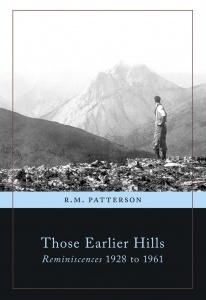
When Richard Mackie recommended I read Patterson, I wasn’t sure what to expect from his writing. Once I tucked into this book by Raymond Murray Patterson, I could see why he made the suggestion, as Patterson and I have some things in common. For one, he is a writer of adventure travel, scribbling down what he found in the natural world. He used a canoe. I used a motorcycle. But his history as a writer seemed to be a progression in writing outdoor adventure: The Dangerous River: Adventure on the Nahanni, The Buffalo Head, Finlay’s River, Far Pastures and Trail to the Interior.
Those Earlier Hills does touch on the Nahanni, a river that was clearly dear to him, and one that had a lasting impact. Since reading this short collection of stories that appeared in The Beaver, including ‘The Nahany Lands’ and ‘South Nahanni Revisited,’ I’ve spoken to members of the Alpine Club of Canada who just last summer ventured up to the northeast of B.C. to canoe the river, mentioning the highlight, which Patterson himself describes, the falls of the Nahanni, a split in the course of falling water caused by a pyramid of rock, dividing the torrential descent of the powerful river. It’s a sight few see, but what a sight, and sound, it must be.
Images such as these, along with the archived photography to back them up, are a hearkening back to a, perhaps, more innocent time, when exploration, or ‘Boys Own’ adventuring, was something to be aspired to from an early age, and one that Patterson fulfilled throughout his life. I can’t help but be reminded of the image described in the final piece ‘With Butler on the Omineca’ in which we get a glimpse into the dreaming space of the boy Patterson was in his home in the north of England.
Out of doors the snow of a hard winter lay deep. Yet for the small boy who was sprawled in front of the library fire, all was warmth and comfort: the book that lay open, its pages held down by a billet of apple wood, was Sir William Butler’s The Wild North Land, and the boy was far away by other snows, along by his campfire on the banks of the mighty Peace River.
For me, the book in question I read sprawled out in front of the fireplace was Farley Mowat’s Never Cry Wolf. But this inclusion into the genesis of adventure travel, the dreaming child who wonders, and is curious about the natural world and the excitement of proving oneself out-of-doors, is one I appreciated from reading Patterson. I’m sure it’ll be far from the last of his writings that I will enjoy, and may just inspire another adventure into the natural world.
I might just pick up a copy of Butler’s book while I’m at it.
